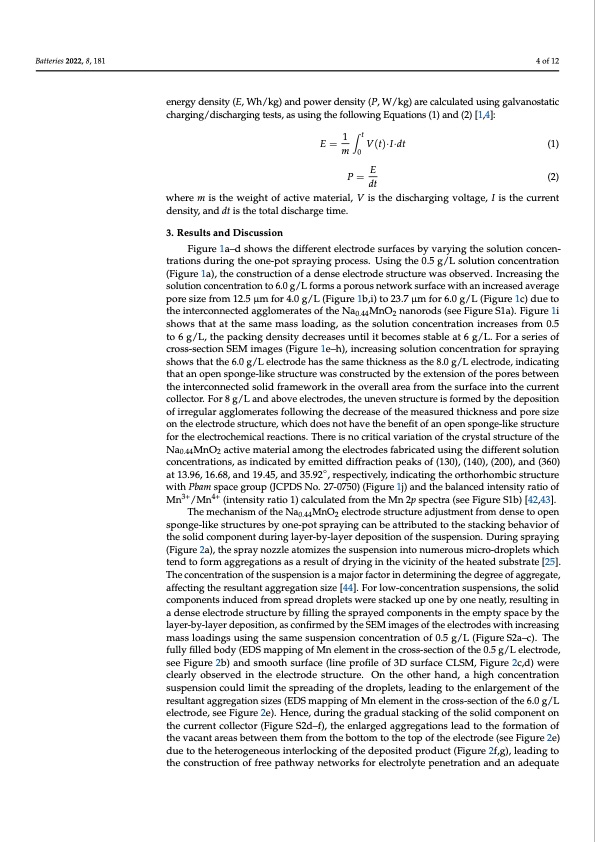
PDF Publication Title:
Text from PDF Page: 004
Batteries 2022, 8, 181 4 of 12 energy density (E, Wh/kg) and power density (P, W/kg) are calculated using galvanostatic charging/discharging tests, as using the following Equations (1) and (2) [1,4]: 1t E = m 0 V(t)·I·dt (1) P=E (2) dt where m is the weight of active material, V is the discharging voltage, I is the current density, and dt is the total discharge time. 3. Results and Discussion Figure 1a–d shows the different electrode surfaces by varying the solution concen- trations during the one-pot spraying process. Using the 0.5 g/L solution concentration (Figure 1a), the construction of a dense electrode structure was observed. Increasing the solution concentration to 6.0 g/L forms a porous network surface with an increased average pore size from 12.5 μm for 4.0 g/L (Figure 1b,i) to 23.7 μm for 6.0 g/L (Figure 1c) due to the interconnected agglomerates of the Na0.44MnO2 nanorods (see Figure S1a). Figure 1i shows that at the same mass loading, as the solution concentration increases from 0.5 to 6 g/L, the packing density decreases until it becomes stable at 6 g/L. For a series of cross-section SEM images (Figure 1e–h), increasing solution concentration for spraying shows that the 6.0 g/L electrode has the same thickness as the 8.0 g/L electrode, indicating that an open sponge-like structure was constructed by the extension of the pores between the interconnected solid framework in the overall area from the surface into the current collector. For 8 g/L and above electrodes, the uneven structure is formed by the deposition of irregular agglomerates following the decrease of the measured thickness and pore size on the electrode structure, which does not have the benefit of an open sponge-like structure for the electrochemical reactions. There is no critical variation of the crystal structure of the Na0.44MnO2 active material among the electrodes fabricated using the different solution concentrations, as indicated by emitted diffraction peaks of (130), (140), (200), and (360) at 13.96, 16.68, and 19.45, and 35.92◦, respectively, indicating the orthorhombic structure with Pbam space group (JCPDS No. 27-0750) (Figure 1j) and the balanced intensity ratio of Mn3+/Mn4+ (intensity ratio 1) calculated from the Mn 2p spectra (see Figure S1b) [42,43]. The mechanism of the Na0.44MnO2 electrode structure adjustment from dense to open sponge-like structures by one-pot spraying can be attributed to the stacking behavior of the solid component during layer-by-layer deposition of the suspension. During spraying (Figure 2a), the spray nozzle atomizes the suspension into numerous micro-droplets which tend to form aggregations as a result of drying in the vicinity of the heated substrate [25]. The concentration of the suspension is a major factor in determining the degree of aggregate, affecting the resultant aggregation size [44]. For low-concentration suspensions, the solid components induced from spread droplets were stacked up one by one neatly, resulting in a dense electrode structure by filling the sprayed components in the empty space by the layer-by-layer deposition, as confirmed by the SEM images of the electrodes with increasing mass loadings using the same suspension concentration of 0.5 g/L (Figure S2a–c). The fully filled body (EDS mapping of Mn element in the cross-section of the 0.5 g/L electrode, see Figure 2b) and smooth surface (line profile of 3D surface CLSM, Figure 2c,d) were clearly observed in the electrode structure. On the other hand, a high concentration suspension could limit the spreading of the droplets, leading to the enlargement of the resultant aggregation sizes (EDS mapping of Mn element in the cross-section of the 6.0 g/L electrode, see Figure 2e). Hence, during the gradual stacking of the solid component on the current collector (Figure S2d–f), the enlarged aggregations lead to the formation of the vacant areas between them from the bottom to the top of the electrode (see Figure 2e) due to the heterogeneous interlocking of the deposited product (Figure 2f,g), leading to the construction of free pathway networks for electrolyte penetration and an adequatePDF Image | Cathode Electrodes High-Rate Cycle-Stable Na-Ion Batteries

PDF Search Title:
Cathode Electrodes High-Rate Cycle-Stable Na-Ion BatteriesOriginal File Name Searched:
batteries-08-00181-v3.pdfDIY PDF Search: Google It | Yahoo | Bing
Salgenx Redox Flow Battery Technology: Salt water flow battery technology with low cost and great energy density that can be used for power storage and thermal storage. Let us de-risk your production using our license. Our aqueous flow battery is less cost than Tesla Megapack and available faster. Redox flow battery. No membrane needed like with Vanadium, or Bromine. Salgenx flow battery
| CONTACT TEL: 608-238-6001 Email: greg@salgenx.com | RSS | AMP |